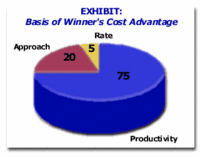CUTTING THE RIGHT COSTS
by Donald V. Potter
When markets turn hostile, managers turn to cost cutting. Reducing cost seems like the most direct route to improving profitability.
Often, though, efforts to control costs make the situation worse.
Winners Don’t Win By Shrinking
“The most desirable cuts are those offering permanent cost advantage.”
Too often, companies try to control costs by giving up customers. Sometimes they do this directly, by deciding not to serve customers that seem unprofitable (but in fact are ensuring the volume that underpins company economics). More often, companies give up customers indirectly and unintentionally. They may decide to drop a seemingly unprofitable product, thereby opening the door to a competitor who takes that volume and more. Or they may reduce product attractiveness – dropping features, letting quality slip, cutting the delivery schedule.
Cuts made at the customer’s expense are risky. Unless everyone in the industry makes the same cuts simultaneously, customers will have a choice – and that choice may be to try a new supplier. When cost cutting reduces a company’s relative ability to serve customers, that company will lose market share.
During hostility market share does matter. Costs are spread over greater volume with greater share. Volume usually brings lower unit costs – the only measure that counts. Less obvious but more important, “ownership” of any customer relationship ensures the lowest cost to serve that customer; so ownership of the largest number of customer relationships with the most industry volume is the low-cost position. Winners win by being big and, if possible, getting bigger.
Sharp Focus on Customers Reduces Cost
The key to cutting costs without losing market share is to maintain a tight focus on customers. Know what they value and what shapes their buying decision. Use that knowledge to:
- Maintain the features and benefits that matter. Make no cuts that will upset or dissatisfy customers and tempt them to shop around.
- Cut any and all costs not closely tied to delivering those features and benefits that customers value.
Highly Focused Overhead Offers Permanent Advantage
“Gains in productivity are more permanent.”
The most desirable cuts are those that offer a permanent cost advantage over competition, rather than simply triggering similar cuts across the industry.
Cuts in the rate of cost (e.g., $/hour, $/lb.) bring a quick relief but can be quickly duplicated. More creative attempts at cost control, such as an innovation in product design or a change in approach to R & D, Manufacturing, Sales, or Service, are also likely to be duplicated in a few years (or even months).
Gains in productivity, while harder to achieve, are more permanent. Companies can improve productivity by knowing exactly what customer benefits they need to offer and how much they can spend to deliver the benefits, then focusing every aspect of their overhead on delivering those benefits. Headcount at most levels will beat industry averages. Going beyond that normal definition of “lean”, however, these companies will evaluate every dollar spent for purchases and capital, within a function to see if it is essential to deliver required customer benefits.

A Snapshot of the Winners
In a hostile market, the big players are the likely winners. Market share counts. Small players can also succeed if they maintain a highly focused overhead structure. Most of the cost advantage of winners over losers is due to productivity. High productivity is the result of either size or focus. A company that combines size with focus is a formidable player in even the toughest of markets.
Closing Thought
Most companies start with last year’s budget to establish this year’s cost targets for organizational groups such as manufacturing, logistics, sales and so forth.
The best companies start with a list of benefits and a portion of the unit price that each function oversees. They then leave the functions the task of delivering those benefits for that unit cost or lower.
(Note: This Perspective was written in the context of the economy in 1991. While some of the companies may have changed their policies or indeed no longer exist, the patterns they exhibit still hold today.)
| Recommended Reading |
| For a greater overall perspective on this subject, we recommend the following related items:
Analyses:
Symptoms and Implications: Symptoms developing in the market that would suggest the need for this analysis.
*** |
